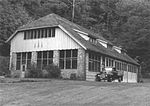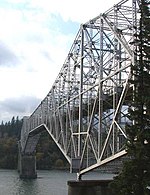Proposed Columbia Gorge casino
In the first decade of the 2000s, the Confederated Tribes of Warm Springs (a group of Indian tribes in the U.S. state of Oregon) sought to build a casino in the Columbia River Gorge. They ended their pursuit of the project in 2013. They considered various sites, as early as 1999; the most extensive plan called for a 60-acre (24 ha) facility with 250 hotel rooms in Cascade Locks, Oregon. The proposed site is within the Columbia River Gorge National Scenic Area, and adjacent to a federally designated wilderness area, but within the city limits of Cascade Locks. (The Columbia River National Scenic Area specifically exempts economic development projects within city limits and supports such growth for cities on both sides of the Columbia River). The plan, which was opposed by Oregon Governor John Kitzhaber, but supported by the City of Cascade Locks, and the government of Hood River County, must be approved by the United States Department of the Interior, and would be the first (or seventh) off-reservation casino in the state.
Excerpt from the Wikipedia article Proposed Columbia Gorge casino (License: CC BY-SA 3.0, Authors).Proposed Columbia Gorge casino
Northwest Forest Lane,
Geographical coordinates (GPS) Address Nearby Places Show on map
Geographical coordinates (GPS)
| Latitude | Longitude |
|---|---|
| N 45.68 ° | E -121.857 ° |
Address
Northwest Forest Lane 1327
97014
Oregon, United States
Open on Google Maps










